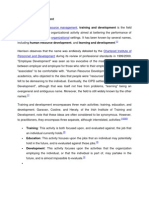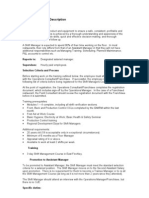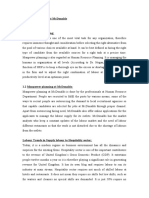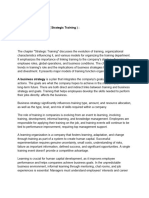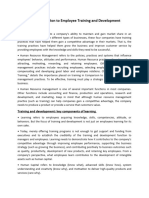Training and Development
Training and Development
Uploaded by
Uvasre SundarCopyright:
Available Formats
Training and Development
Training and Development
Uploaded by
Uvasre SundarOriginal Title
Copyright
Available Formats
Share this document
Did you find this document useful?
Is this content inappropriate?
Copyright:
Available Formats
Training and Development
Training and Development
Uploaded by
Uvasre SundarCopyright:
Available Formats
MINI PROJECT REPORT ON TRAINING AND DEVELOPMENT FOR INTERNATIONAL EMPOLYEES
BY UVASRE.T.S(3511220003) UMESHWARAN.L.B(3511220007)
Introduction Employee development is not just the responsibility of the employee. In todays diverse workforce ,business practices have evolved to reflect economic competitiveness in developing and retaining talented employees. Organizations are continually seeking new solutions to assess, understand, and strategize employee development. One of the greatest challenges faced by managers is the strategic personal development of their employees in order to ensure effective use of their talent. To properly manage this vital resource, they must identify their challenges and then implement employee development and training for improvement. Profiles Internationals employee development solutions will help managers effectively manage, motivate, and empower employees. Effective management requires insight about the core characteristics of individuals. Profiles International provides invaluable tools for increasing consistency in managing employees. What makes Profiles Internationals tools the leading tools in the industry is our exclusive Job Fit technology. Good management is all about understanding "fit" and how employees fit with their job, their manager, their team, and the organization. By understanding fit, managers have greater knowledge of how to effectively interact with and coach the individual employees they manage. WHAT IS TRAINING? Training refers to a planned effort by a company to facilitate employees' learning of jobrelated competencies. These competencies include knowledge, skills, or behaviors that are critical for successful job performance. The goal of training is for employees to master the knowledge, skill, and behaviors emphasized in training programs and to apply them to their day-to-day activities. For a company to gain a competitive advantage, its training has to involve more than just basic skill development. That is, to use training to gain a competitive advantage, a company should view training broadly as a way to create intellectual capital. Intellectual capital includes basic skills (skills needed to perform one's job), advanced skills (such as how to use technology to share information with other employees), an understanding of the customer or manufacturing system, and selfmotivated creativity. Keep in mind that, traditionally, most of the emphasis on training has been at the basic and advanced skill levels. But some experts estimate that soon up to 85 percent of jobs in the United States and Europe will require extensive use of knowledge. Employees will be required not only to understand the service or product development system but also to share knowledge and to creatively use it to modify a product or serve the customer. Many companies have adopted this broader perspective, which is known as high-leverage training. High-leverage training is linked to strategic business goals and objectives, uses an instructional design process to ensure that training is effective, and compares or benchmarks the company's training programs against training programs in other companies.
High-leverage training practices also help to create working conditions that encourage continuous learning. Continuous learning requires employees to understand the entire work system, including the relationships among their jobs, their work units, and the company. Employees are expected to acquire new skills and knowledge, apply them on the job, and share this information with other employees. Managers take an active role in identifying training needs and help to ensure that employees use training in their work. To facilitate the sharing of knowledge, managers may use informational maps that show where knowledge lies within the company (for example, directories that list what individuals do as well as the specialized knowledge they possess) and use technology such as groupware or the Internet that allows employees in various business units to work simultaneously on problems and share information. The emphasis on high-leverage training has been accompanied by a movement to link training to performance improvement. Companies have lost money on training because it is poorly designed, because it is not linked to a performance problem or business strategy, or because its outcomes have not been properly evaluated. That is, companies have been investing money into training simply because of the belief that it is a good thing to do. The perspective that the training function exists to deliver programs to employees without a compelling business reason for doing so is being abandoned. Today, training is being evaluated not on the basis of the number of programs offered and training activity in the company but on how training addresses business needs related to learning, behavior change, and performance improvement. In fact, training is becoming more performancefocused. That is, training is used to improve employee performance, which leads to improved business results. Training is seen as one of several possible solutions to improve performance. Other solutions include actions such as changing the job or increasing employee motivation through pay and incentives. Providing educational opportunities for all employees. These educational opportunities may include training programs, but they also include support for taking courses offered outside the company, self-study, and learning through job rotation. Performance improvement as an ongoing process that is directly measurable rather than a one-time training event. Demonstrating to executives, managers, and trainees the benefits of training. Learning as a lifelong event in which senior management, trainer managers, and employees have ownership. Training being used to help attain strategic business objectives, which help companies gain a competitive advantage. PricewaterhouseCoopers is a good example of a company that uses high-leverage training. Its Learning and Education (L&E) team was restructured to better link it to the business goals related to value and impact.
L&E works with the business to understand what it wants education to be. It ensures ongoing innovation in training delivery and instructional methods by evaluating emerging technologies and using them in small pilot projects. The chief learning officer in charge of L&E is a member of the company's leadership team, which gives that individual the opportunity to discuss ideas regarding training methods, delivery, and content with other top-level managers. L&E sponsors traditional and virtual classroom courses, self-study, team-based learning, action learning projects, coaching and mentoring, and conferences, and it has served more than 150,000 users each year, with over 6,000 courses, 12,000 classroom-based training sessions, and 19,000 Web-based training sessions. PricewaterhouseCoopers uses a learning management system to create a single access point for training activities. To help employees learn on an as-needed basis, the company's e-learning includes video and audio conferencing, virtual classrooms, and web- casting. To evaluate the success of training, L&E considers its influence on outcomes, such as retention of top people. Also, focus groups are used to determine whether trainees and managers are satisfied with the training. A program on sustainability was designed to help partners understand how to provide solutions for their clients. The company's investment in the program has paid off. The company believes it has achieved a return on investment of more than 1,000 percent in new business sold and reputation gains in the marketplace. In the future, L&E plans to further strengthen the relationship between training, development, and the business by focusing on how it can make learning even more accessible and closer to the point where employees need it. L&E wants to integrate learning and knowledge to speed employees' development and improve their competencies. This discussion is not meant to underestimate the importance of "traditional training" (a focus on acquisition of knowledge, skills, and abilities), but it should alert you that for many companies training is evolving from a focus on skills to an emphasis on learning and creating and sharing knowledge. DESIGNING EFFECTIVE TRAINING The training design process refers to a systematic approach for developing training programs. Figure 1 presents the seven steps in this process. Step 1 is to conduct a needs assessment, which is necessary to identify whether training is needed. Step 2 is to ensure that employees have the motivation and basic skills necessary to master the training content. Step 3 is to create a learning environment that has the features necessary for learning to occur. Step 4 is to ensure that trainees apply the training content to their jobs. This step involves having the trainee understand how to manage skill improvement as well as getting co-worker and manager support.
Training Design Process
1. Conducting Needs Assessment Organizational Analysis Person Analysis Task Analysis 2. Ensuring Employees' Readiness for Training Attitudes and Motivation Basic Skills 3. Creating a Learning Environment Learning Objectives Meaningful Material Practice Feedback Community of Learning Modeling Program Administration
5. Developing an Evaluation Plan Identify Learning Outcomes Choose Evaluation Design Plan Cost-Benefit Analysis
4. Ensuring Transfer of Training Self-Management Peer and Manager Support
6. Selecting Training Method Traditional E-learning
7. Monitoring and Evaluating the Program Conduct Evaluation Make Changes to Improve the Program
Step 5 is to develop an evaluation plan. Developing an evaluation plan includes identifying what types of outcomes training is expected to influence (for example, learning, behavior, skills), choosing an evaluation design that allows you to determine the influence of training on these outcomes, and planning how to demonstrate how training affects the "bottom line" (that is, using a cost-benefit analysis to determine the monetary benefits resulting from training). Step 6 is to choose the training method based on the learning objectives and learning environment. This step may include a traditional training method of face-to-face interaction with a trainer or e-learning using CD-ROM or Web-based training. Step 7 is to evaluate the program and make changes in it or revisit any of the earlier steps in the process to improve the program so that learning, behavior, change, and the other learning objectives are obtained. The training design process shown in Figure 1 is based on principles of Instructional System Design. Instructional System Design (ISD) refers to a process for designing and developing training programs. There is not one universally accepted instructional systems development model. The training design process sometimes is referred to as the ADDIE model because it includes analysis, design, development, implementation, and evaluation. In Figure 1.1, Step 1, conducting needs assessment, and Step 2, ensuring employees' readiness for training, are related to analysis. The next three stepscreating a learning environment, ensuring transfer of training, and developing an evaluation planare design issues. Step 6, selecting and using a training method, relates to implementation. Step 7, monitoring and evaluating the program, relates to evaluation. Regardless of the specific ISD approach used, all share the following assumptions: Training design is effective only if it helps employees reach instructional or training goals and objectives. Measurable learning objectives should be identified before the training program begins. Evaluation plays an important part in planning and choosing a training method, monitoring the training program, and suggesting changes to the training design process. American Infrastructure (AI), located in Worcester, Pennsylvania, uses the ADDIE model to design training for its employees involved in construction and mining. Templates based on the ADDIE model are used to design and develop training and development programs. AI uses the templates to ensure that needs assessment is conducted and evaluation is considered as training and development programs are being designed. The use of the templates also helps to show that training and development programs are aligned with the business strategy and are designed to contribute to important business results which helps AI get the necessary financial support and encouragement from key organizational stakeholders. Some training professionals argue that the ISD model is flawed for several reasons. First, in organizations the training design process rarely follows the neat, orderly, step- by-step approach of activities shown in Figure 1. Second, in trying to standardize their own ISD method used in the training function, some organizations require trainers to pro- vide detailed documents of each activity found in the model. This adds time and cost to developing a training program. Third, the ISD implies an end point: evaluation. However, good instructional design requires an iterative process of design, execution, evaluation, and reconsideration of the needs that the program was designed to meet as well as the learning environment, the transfer of training, and all the other activities in the ISD process. Despite these
criticisms, the ISD model can be considered a set of general guidelines that trainers need to follow to ensure effective training. The training design process should be systematic yet flexible enough to adapt to business needs. Different steps may be completed simultaneously. Keep in mind that designing training unsytematically will reduce the benefits that can be realized. For example, choosing a training method before determining training needs or ensuring employees' readiness for training increases the risk that the method chosen will not be the most effective one for meeting training needs. Also, training may not even be necessary and may result in a waste of time and money! Employees may have the knowledge, skills, or behavior they need but simply not be motivated to use them. The introduction of new technologies such as podcasting highlights a shift from trainees having to learn from an instructor in one location to trainees learning independently and not being bound to learn in the workplace.
Still, good training design requires determining the trainees' needs, identifying resources so that trainees can learn what they need to know, and providing them with access to reference materials and knowledge bases when they encounter problems, issues, or questions on the job. The development of a Web-based training program focusing on teaching managers skills needed to run effective business meetings provides a good example of use of the instructional design process. The first step of the process, needs assessment, involved determining that managers lacked skills for conducting effective meetings and helped to identify the type of meetings that managers were involved in. The needs assessment process involved interviewing managers and observing meetings. The needs assessment process also identified the most appropriate training method. Because the managers were geographically dispersed and had easy access to computers and because the company wanted a self-directed, self-paced program that the managers could complete during free time in their work schedule, the training designers and company management decided that Web-based training was the appropriate method. Because training was going to be conducted over the Web, the designers had to be sure that managers could access the Web and were familiar with tools for using the Web (e.g., Web browsers). This relates to determining the managers' readiness for training. The next step was to create a positive learning environment on the Web. Designers made sure that the program objectives were clearly stated to the trainees and provided opportunities within the program for exercises and feedback. For example, trainees were asked to prepare an outline for the steps they would take to conduct an effective meeting. The designers built into the program a feedback system that indicated to the managers which of the steps they outlined were correct and which needed to be changed. The designers also built in assessment tests allowing the trainees to receive feedback through the program and to skip ahead or return to earlier material based on their scores on the tests. The assessment included a test of meeting skills that the managers completed both prior to and after completing the program. The assessment tests were stored in a data bank that the company could use to evaluate whether trainees' meeting skills improved from pre-training levels.
You might also like
- OnboardingDocument19 pagesOnboardingWilliamAllanGibson100% (4)
- Staffing Plan For Starbucks Store ManagerDocument20 pagesStaffing Plan For Starbucks Store ManagerMiriam Mccormick89% (9)
- Crew Trainer Application - McDonaldsDocument6 pagesCrew Trainer Application - McDonaldsHaydenNo ratings yet
- Shift Manager PoliciesDocument14 pagesShift Manager PoliciesAbidou Deangelo100% (1)
- Training & Development at McDonaldsDocument3 pagesTraining & Development at McDonaldsMitzahecool60% (10)
- Mcdonalds Made For YouDocument4 pagesMcdonalds Made For Youshivi730% (1)
- Key Point For Day 1 MDPDocument4 pagesKey Point For Day 1 MDPAmei TingNo ratings yet
- Training & Development at McDonald'sDocument11 pagesTraining & Development at McDonald'sAmit Pandey50% (2)
- McDonalds Inventory Management PracticeDocument4 pagesMcDonalds Inventory Management PracticePiyush DewanNo ratings yet
- Pizza Hut Employee ManualDocument41 pagesPizza Hut Employee ManualRidhima HirwaniNo ratings yet
- Buns & Dressings Grilled Direct SOCDocument1 pageBuns & Dressings Grilled Direct SOCpartabo50% (4)
- Prs 441 BlueprintDocument36 pagesPrs 441 Blueprintapi-375724965No ratings yet
- Shift Running Floor Manager - Job DescriptionDocument2 pagesShift Running Floor Manager - Job DescriptioncocosheenNo ratings yet
- Starbucks Reward and PerformanceDocument5 pagesStarbucks Reward and PerformanceTam Mi100% (1)
- McDonalds - Recruitment & Selection & TrainingDocument4 pagesMcDonalds - Recruitment & Selection & TrainingIdonia CallejaNo ratings yet
- Paper HRP Coca Cola FixDocument25 pagesPaper HRP Coca Cola FixTri Wahyuni100% (1)
- Work Health & Safety Policy: Incident & Injury ManagementDocument1 pageWork Health & Safety Policy: Incident & Injury Managementvinayak nautiyal100% (1)
- Project On Training and DevelopmentDocument77 pagesProject On Training and DevelopmentPriyanka Yadav89% (9)
- The Scarlet Letter - BookDocument125 pagesThe Scarlet Letter - BookDiana CavasdanNo ratings yet
- Edward Scissorhands - Theme ChartDocument2 pagesEdward Scissorhands - Theme ChartJohn WilliamsonNo ratings yet
- Mcdonald S Business Strategy Linked To Its Training & Development ProcessDocument16 pagesMcdonald S Business Strategy Linked To Its Training & Development ProcessAyush Khera100% (2)
- Final Assignment of HRM On MaCdonaldsDocument27 pagesFinal Assignment of HRM On MaCdonaldsgoldhazyy0% (1)
- Example: Starbucks Performance AppraisalDocument1 pageExample: Starbucks Performance AppraisalKim Tuyền NguyễnNo ratings yet
- HRM MCDocument56 pagesHRM MCkhaj14100% (1)
- MCD Recruitment TrainingDocument7 pagesMCD Recruitment TrainingSann RaksmeyNo ratings yet
- McDonalds Recruitment Selection TrainingDocument6 pagesMcDonalds Recruitment Selection TrainingMisha SaeedNo ratings yet
- Case: Motivating Partners at StarbucksDocument2 pagesCase: Motivating Partners at StarbucksJe AnnNo ratings yet
- Crew Role DescriptionDocument1 pageCrew Role DescriptionAgnieszka WaligóraNo ratings yet
- MC DonaldsDocument14 pagesMC DonaldsUrmi Choudhary0% (1)
- Training and Devlopment at WockhardtDocument52 pagesTraining and Devlopment at Wockhardtsumit03dNo ratings yet
- Training Manager or Trainer or Training Specialist or Training CDocument3 pagesTraining Manager or Trainer or Training Specialist or Training Capi-77406483No ratings yet
- Mcdonald HR ProjectDocument22 pagesMcdonald HR Projectrabiabcd82% (11)
- McDonalds HR ProjectDocument21 pagesMcDonalds HR ProjectWayne Cunningham100% (1)
- Compiled by - Tanya (BFT/18/639) : Assignment 1Document12 pagesCompiled by - Tanya (BFT/18/639) : Assignment 1TANYA TANYANo ratings yet
- McDonalds NewDocument24 pagesMcDonalds NewReshma RavinNo ratings yet
- HRM - A Case Study On - Starbucks CorporationDocument12 pagesHRM - A Case Study On - Starbucks CorporationTerry Vincenzo50% (2)
- People Management at McDonaldsDocument8 pagesPeople Management at McDonaldsAdnan Yusufzai0% (1)
- Shift Leadership ResponsibilityDocument3 pagesShift Leadership ResponsibilityRandolph LatimerNo ratings yet
- Training N DevelopmentDocument8 pagesTraining N Developmenthumble306102No ratings yet
- POM REPORT On McDonald'sDocument22 pagesPOM REPORT On McDonald'snaveed009100% (1)
- Kpis in WellnessDocument5 pagesKpis in WellnessAisha BarbieNo ratings yet
- Group's - 9 McdonaldsDocument26 pagesGroup's - 9 McdonaldsSneha ChowdharyNo ratings yet
- Operations and Information Management CHECK, FORMAT AND NUMBERDocument13 pagesOperations and Information Management CHECK, FORMAT AND NUMBERShahnewaj SharanNo ratings yet
- Mcdonald PPT by BhaveshDocument11 pagesMcdonald PPT by BhaveshBhavesh AgnaniNo ratings yet
- Human Resource ManagementDocument24 pagesHuman Resource ManagementMrVishu100% (1)
- McDonalds FinalDocument22 pagesMcDonalds Finalashishgiri50% (4)
- Medd's Cafe - Group Assignment DraftDocument20 pagesMedd's Cafe - Group Assignment DraftB UNo ratings yet
- Day 1 Training Plan Onboarding EditionDocument2 pagesDay 1 Training Plan Onboarding EditionLilly Kenyon-kuckoNo ratings yet
- Incentive PlansDocument21 pagesIncentive Plansnmhrk1118No ratings yet
- Starbucks Cleanliness Standards - Job Aid - Elimination of FliesDocument1 pageStarbucks Cleanliness Standards - Job Aid - Elimination of Flieszorthog100% (1)
- Employee Training & DevelopementDocument29 pagesEmployee Training & DevelopementGr8 zaibi100% (7)
- Sumiya ProjectDocument64 pagesSumiya Projectmunirathnamkarthika30No ratings yet
- Lesson 1 - Introduction To Employee Training & DevelopmentDocument21 pagesLesson 1 - Introduction To Employee Training & DevelopmentautoworksbhpNo ratings yet
- FinalsDocument176 pagesFinalsautoworksbhpNo ratings yet
- UNIT - IVDocument27 pagesUNIT - IVUttkarsh GuptaNo ratings yet
- Chapter 2 Summary (Strategic Training)Document9 pagesChapter 2 Summary (Strategic Training)salzadjali15No ratings yet
- Lesson-3Document22 pagesLesson-3Jessua Delos Santos BarsagaNo ratings yet
- Kamya DissertationDocument63 pagesKamya DissertationNikhil VishwakarmaNo ratings yet
- Chapter 1 Training Amd DevelopmentDocument10 pagesChapter 1 Training Amd DevelopmentSumerah Saeed100% (1)
- Chapter - 3 Theoritical Frame WorkDocument22 pagesChapter - 3 Theoritical Frame WorkNarasimhaPrasadNo ratings yet
- The Ultimate Employee Training Guide- Training Today, Leading TomorrowFrom EverandThe Ultimate Employee Training Guide- Training Today, Leading TomorrowNo ratings yet
- GSTR1 FormatDocument55 pagesGSTR1 FormatUvasre SundarNo ratings yet
- A Study On Customer Perception of ULIP of Bajaj Allianz Life Insurance Co. LTD With Mutual FundDocument88 pagesA Study On Customer Perception of ULIP of Bajaj Allianz Life Insurance Co. LTD With Mutual FundbrijeshcocoNo ratings yet
- Noc Letter Format From EmployerDocument1 pageNoc Letter Format From EmployerUvasre SundarNo ratings yet
- One Way Anova For Gender and Attrition H0: There Is No Sig Diff Bet Gender ND Att H1: There Is Sig DiffDocument2 pagesOne Way Anova For Gender and Attrition H0: There Is No Sig Diff Bet Gender ND Att H1: There Is Sig DiffUvasre SundarNo ratings yet
- Importance of Induction Process - (Table of Contents) - GoogolsoftDocument84 pagesImportance of Induction Process - (Table of Contents) - GoogolsoftUvasre Sundar100% (1)
- Presentation About Edge DetectionDocument23 pagesPresentation About Edge DetectionUvasre SundarNo ratings yet
- Summer Training Report On Aavin ProductionDocument58 pagesSummer Training Report On Aavin ProductionUvasre Sundar100% (2)
- State/Central Civil Pension: 7.2 Applicability of Pension RulesDocument2 pagesState/Central Civil Pension: 7.2 Applicability of Pension RulesUvasre SundarNo ratings yet
- For SPSS AnalysisDocument22 pagesFor SPSS AnalysisUvasre SundarNo ratings yet
- Entrepreneur Interview FormatDocument3 pagesEntrepreneur Interview FormatUvasre SundarNo ratings yet
- Summer Training Report FormatDocument13 pagesSummer Training Report FormatUvasre SundarNo ratings yet
- Aptitude QuestionsDocument14 pagesAptitude QuestionsUvasre SundarNo ratings yet
- Differences Between HRM and Personnel ManagementDocument4 pagesDifferences Between HRM and Personnel ManagementUvasre Sundar100% (1)
- Profit Maximization and Wealth MaximizationDocument4 pagesProfit Maximization and Wealth MaximizationUvasre Sundar100% (5)
- How To Prepare A ReportDocument1 pageHow To Prepare A ReportUvasre SundarNo ratings yet
- Qspiders IncubationDocument16 pagesQspiders Incubationshrawandubey06No ratings yet
- FullDocument336 pagesFullAnonymous 9i0oA5Ya100% (1)
- Answers in Final LMC 2 AY 2021 2022Document5 pagesAnswers in Final LMC 2 AY 2021 2022vince magallonesNo ratings yet
- Bedmaking HandoutsDocument6 pagesBedmaking Handoutserika lou NoelNo ratings yet
- E3 LSK Listening 1Document23 pagesE3 LSK Listening 1Victor1234567No ratings yet
- Third Provisional Allotment List-Admission 2021-2022Document2 pagesThird Provisional Allotment List-Admission 2021-2022Sambit Sourav PaulNo ratings yet
- Hovenia Dulcis - Scientific Review On Usage, Dosage, Side Effects - ExamineDocument5 pagesHovenia Dulcis - Scientific Review On Usage, Dosage, Side Effects - Examineozman blooriNo ratings yet
- Normal and Abnormal Findings in The Assessment of The MouthDocument2 pagesNormal and Abnormal Findings in The Assessment of The MouthPamela Olive Alia OcanNo ratings yet
- Directorate of Collegiate Education ChennaiDocument10 pagesDirectorate of Collegiate Education ChennaiJohneeNo ratings yet
- Activity SheetDocument18 pagesActivity SheetAngel IloNo ratings yet
- CaliLantern Guide V3.1Document36 pagesCaliLantern Guide V3.1Enrique TapiaNo ratings yet
- Aqv 09 12 Uge Ewe Ugfeur 10uge Uwe Uwfeurgsm Sansung Inverter PlacaDocument167 pagesAqv 09 12 Uge Ewe Ugfeur 10uge Uwe Uwfeurgsm Sansung Inverter PlacaAdriano NascimentoNo ratings yet
- Advaita and Trinity: Reflections On The Vedantic and Christian Experience Off God With Reference To Buddhist Non-DualismDocument24 pagesAdvaita and Trinity: Reflections On The Vedantic and Christian Experience Off God With Reference To Buddhist Non-DualismBen DouglasNo ratings yet
- Dismantling Joint 3 To 40 ANSI 150 VJ DSDocument1 pageDismantling Joint 3 To 40 ANSI 150 VJ DSmuralyyNo ratings yet
- Stationarity & AR, MA, ARIMA, SARIMADocument6 pagesStationarity & AR, MA, ARIMA, SARIMAAdil Bin Khalid100% (1)
- AP Phy Rotational Motion - Practice 1Document6 pagesAP Phy Rotational Motion - Practice 1TofuS4nNo ratings yet
- Optisonic 3400: Ultrasonic Flowmeter For Liquids in All Industrial ApplicationsDocument16 pagesOptisonic 3400: Ultrasonic Flowmeter For Liquids in All Industrial ApplicationsOmar SaeedNo ratings yet
- M.H.joshI At: Shahapur DT/TQ: Koppal Phone: 9739535251Document7 pagesM.H.joshI At: Shahapur DT/TQ: Koppal Phone: 9739535251joshimhNo ratings yet
- Mikee EncodedDocument2 pagesMikee EncodedjaysonNo ratings yet
- Fahad PPT Seminar FinalDocument22 pagesFahad PPT Seminar FinalManu S NadesanNo ratings yet
- Assignment Number 2 NdebeleDocument6 pagesAssignment Number 2 NdebeleCajo CageNo ratings yet
- BARNES, Harry Elmer - The Struggle Against The Historical Blackout (1952)Document87 pagesBARNES, Harry Elmer - The Struggle Against The Historical Blackout (1952)Ulrick VarangeNo ratings yet
- ACS800 Sine Filters Revg PDFDocument72 pagesACS800 Sine Filters Revg PDFZinou ZizouNo ratings yet
- Planj Bio t4Document303 pagesPlanj Bio t4Nur Anida IsmailNo ratings yet
- Billiards Without A MasterDocument247 pagesBilliards Without A Mastervăn lợi NguyễnNo ratings yet
- Diss Mod2 Nature and Functions of Social Sciences DisciplinesDocument33 pagesDiss Mod2 Nature and Functions of Social Sciences DisciplinesJulie Ann SambranoNo ratings yet
- Scope CC 2151Document146 pagesScope CC 2151HOD Scitpl [Sands]No ratings yet







